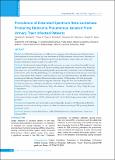Please use this identifier to cite or link to this item:
https://hdl.handle.net/20.500.14356/1709Full metadata record
| DC Field | Value | Language |
|---|---|---|
| dc.contributor.author | Chaudhary, P | - |
| dc.contributor.author | Bhandari, D | - |
| dc.contributor.author | Thapa, K | - |
| dc.contributor.author | Thapa, P | - |
| dc.contributor.author | Shrestha, D | - |
| dc.contributor.author | Chaudhary, H K | - |
| dc.contributor.author | Shrestha, A | - |
| dc.contributor.author | Parajuli, H | - |
| dc.contributor.author | Gupta, B P | - |
| dc.date.accessioned | 2023-05-19T05:39:58Z | - |
| dc.date.available | 2023-05-19T05:39:58Z | - |
| dc.date.issued | 2016 | - |
| dc.identifier.citation | ChaudharyP., BhandariD., ThapaK., ThapaP., ShresthaD., ChaudharyH. K., ShresthaA., ParajuliH., & GuptaB. P. (2016). Prevalence of Extended Spectrum Beta-Lactamase Producing Klebsiella Pneumoniae Isolated From Urinary Tract Infected Patients. Journal of Nepal Health Research Council, 14(2). https://doi.org/10.33314/jnhrc.v14i2.799 | en_US |
| dc.identifier.issn | Print ISSN: 1727-5482; Online ISSN: 1999-6217 | - |
| dc.identifier.uri | http://103.69.126.140:8080/handle/20.500.14356/1709 | - |
| dc.description | Original Article | en_US |
| dc.description.abstract | Abstract Background: Klebsiella pneumoniae, one of the bacterial agents associated with urinary tract infection has been often implicated as a major extended spectrum beta-lactamase (ESBL) producer in last few decades. This study was designed to assess the prevalence of ESBL producing Klebsiella pneumoniae in urinary isolates at a tertiary care hospital in Kathmandu, Nepal, from July to December 2014. Methods: One thousand nine hundred eighty six mid-stream urine specimens were collected aseptically from the clinically suspected patients of urinary tract infections attending Capital Hospital and Research Center, Kathmandu. The samples were processed following standard guidelines as recommended by American Society for Microbiology (ASM) and the isolates including Klebsiella spp. were identified using the specific biochemical and sugar fermentation tests recommended by ASM. Antibiotic sensitivity testing was done by modified Kirby-Bauer disk diffusion method and interpreted following Clinical and Laboratory Standards Institute (CLSI) guidelines. Klebsiella pneumoniae isolates showing resistance upon initial screening with ceftriaxone (30 μg) disc were then confirmed for ESBL production by phenotypic confirmatory disc diffusion test (PCDDT) using ceftazidime (30 µg) and ceftazidime + clavulanic acid (30 µg + 10µg) and cefotaxime (30 µg) and cefotaxime + clavulanic acid (30 µg +10µg) disc as per CLSI guidelines. Results: Out of a total 1986 specimens investigated, Escherichia coli was isolated in 309 (83.9%) and Klebsiella pneumoniae in 38 (10.3%) cases. Initial screening with ceftriaxone disc revealed 18 isolates of Klebsiella pneumoniae to be resistant. Further testing by PCDDT method confirmed 7 (18.4%) Klebsiella pneumoniae isolates to be ESBL producers. Conclusions: Compared to some earlier studies done in Nepal, higher prevalence of ESBL-producing Klebsiella pneumoniae was observed warranting a national surveillance for routine monitoring of ESBL producing Klebsiella pneumoniae isolates. Keywords: Extended spectrum beta-lactamase (ESBL); klebsiella pneumonia; Nepal; prevalence; urinary tract infection (UTI). | en_US |
| dc.language.iso | en | en_US |
| dc.publisher | Nepal Health Research Council | en_US |
| dc.relation.ispartofseries | May-Aug, 2016;799 | - |
| dc.subject | Extended spectrum beta-lactamase (ESBL) | en_US |
| dc.subject | Klebsiella pneumonia | en_US |
| dc.subject | Nepal | en_US |
| dc.subject | Prevalence | en_US |
| dc.subject | Urinary tract infection (UTI) | en_US |
| dc.title | Prevalence of Extended Spectrum Beta-Lactamase Producing Klebsiella Pneumoniae Isolated From Urinary Tract Infected Patients | en_US |
| dc.type | Journal Article | en_US |
| local.journal.category | Original Article | - |
| Appears in Collections: | Vol. 14 No. 2 Issue 33 May-Aug 2016 | |
Files in This Item:
| File | Description | Size | Format | |
|---|---|---|---|---|
| 799-Article Text-1477-2-10-20170528.pdf | Fulltext Download | 202.32 kB | Adobe PDF |  View/Open |
Items in DSpace are protected by copyright, with all rights reserved, unless otherwise indicated.
